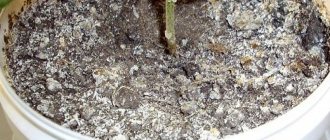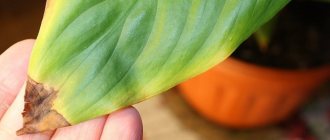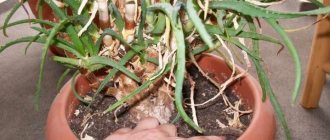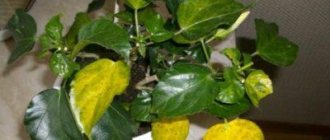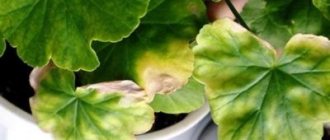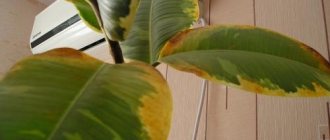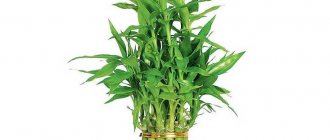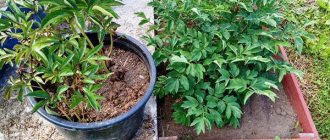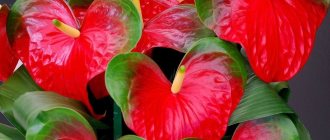Dry air is what immediately comes to mind when we see dry tips on indoor plants. But not everything revolves around humidity. There are other reasons why yellow or brown spots appear on leaves.
Every gardener has encountered the problem of dry leaf tips in indoor plants at least once. It doesn’t matter whether you grow begonias, spathiphyllum, roses or orchids. At the same time, potted flowers do not show other alarming symptoms, continuing to grow and even blooming. Let's try to figure out why the tips of the leaves of indoor plants dry out, whether it is dangerous and how to eliminate the defect.
Most often, yellow, brown and even black dry tips are the result of improper care or a reaction to the activity of pests. The process of natural aging cannot be ruled out. True, the latter can be delayed by creating the most comfortable conditions for the green pet.
Diagnosis is an important stage for prescribing the correct “treatment”
joygarden.com
To determine why the leaf tips of spathiphyllum, geranium and other plants turn yellow and dry, diagnose the condition of your green pet. The complexity of the procedure lies in the fact that the search for the cause most often has to be carried out from the opposite direction, i.e. by exclusion method.
- Make sure that the depressed state of the plant is not caused by pests . They like to hide on shoots and on the undersides of leaves, so inspect these places especially carefully. Parasites can also be on the roots. But don't rush to check it out. Perhaps the reason is completely different, and you will only damage the root system in vain.
- Assess the hardness of the water used for irrigation . If you do not settle tap water before watering, plants may suffer from high levels of salts, fluoride, chlorine and other heavy substances that change the characteristics of the soil, making the substrate uncomfortable.
- Compare your fertilization schedule to the recommended fertilization schedule . The reason why the leaves of palm trees, dracaena, ficus, orchids and other crops dry out may be frequent or, conversely, rare feeding.
- Measure air humidity levels . Assess how much air humidity in your apartment is suitable for moisture-loving species.
- Analyze whether the plant is cramped in the pot . One of the alarm bells may be roots emerging from the drainage hole.
- Determine the moisture content of the substrate and the degree to which it dries out between waterings . This can be done either by touch or using indicators that are sold in flower shops.
If you find a deviation from the norm in just one point, the cause of dry ends is usually easy to eliminate. But if, after a preliminary analysis, you see several problems at once, you will have to take comprehensive measures.
How to solve the problem with dry tips in seedlings
If you notice the problem in time, it can also be quickly eliminated. If you leave everything to chance, the seedlings will simply die. But so much time and effort was spent on it.
So as not to start over. And this is long and tedious. It's better to save what you have. And this is quite real.
How to solve a problem:
- All kinds of seedling diseases are associated with constant overwatering. Excess water is very bad. Constantly wet roots begin to rot. If this has already happened. Carefully dig up the seedlings. At this time, prepare new soil. Since the roots are wet, it is best not to water the seedlings right away. It is best to dry the roots in the sun. The main thing is not to overdo it.
- Water. The quality of water, especially tap water, leaves much to be desired. Therefore, if there is no other water, then you can water it. Only this water, it is best to leave it for a day in some container. So that some of the chemicals evaporate.
- Fertilizer. It can be either a lot or a little. In any case, it is better to underfeed. But if this happens, then it is better to replant it again in new soil.
- It is not advisable to use the same cups or any other container twice. Pests may remain in them.
- Acidic soil may not be suitable as a soil. This may interfere with the reaction. Plants do not like soil with a high acidity content. Therefore, when buying land you should be more careful. So that in the end you don’t have to start all over again.
- There may be a lack of phosphorus, potassium, iron, magnesium and so on. Pay special attention to this.
- There must be sand in the soil. Sea sand is best. Earth and sand are mixed and a good soil is obtained. You can also sprinkle sand on top. This will help with good soil absorption. And it will maintain optimal humidity. In the case of seedlings, this is necessary.
Whatever happens to a house plant or seedling, you always need to be on guard. Frequent inspection will not be superfluous. Quite the contrary. Will protect your grower from unwanted consequences.
Let’s start “treating” indoor flowers: general rules
mysunnybrighthome.com
Regardless of the reason why the leaves of anthurium, Kalanchoe or chlorophytum dry out, any plant could use emergency help, which consists of the following:
- Replacing the surface layer of soil with fresh substrate . This will reduce the risk of soil contamination and eliminate salt deposits from hard water.
- Cleaning the surface of leaves from dust . For plants with delicate leaves, this can be done using a shower. If the leaves are denser and not prone to mechanical damage, use a soft cloth.
You should avoid bathing in the shower if the leaves of plants have edges (such as those of violets).
- Change in air humidity . Spraying, a humidifier, or a regular container of water placed next to the flower will help with this.
If you suspect that the plant has been flooded, do not increase the humidity until the soil dries out.
- Revisiting principles of care . Make sure the plant is getting exactly what it needs from you. Each green pet is individual, and therefore, the care program needs to be selected individually.
Scale insects on plants
Scale insects are quite difficult to detect on plants. The insect is mobile and very small, only 5 mm. The insect is very dangerous, as it sucks the juice from plants. As a result, the leaves fall off, dry out, and then the entire plant dies.
Scale insects on houseplants are dangerous and difficult to remove, but there are ways to fight the enemy of houseplants at home.
Conventional methods of controlling insect pests often do not bring positive results. This is explained by the fact that the scale insect has a wax shield, which makes it invulnerable to chemicals. But it is still possible to defeat a dangerous enemy, you just need to be patient, since the destruction process is long. In addition, destruction requires the right approach.
Reason #1. Dry air in the apartment
gardenista.com
Many representatives of tropical latitudes, for whom warmth and high humidity are the norm, have moved to live in our apartments. But creating such conditions at home can be extremely difficult, especially during the heating season, when the already dry air dries out completely.
Don’t think that you can save the situation by increasing watering. By doing this, you will only achieve rotting of the root system, and therefore, the leaves will receive even less moisture.
The following methods will help increase humidity:
- Spraying . It is advisable to irrigate the leaves with a spray bottle at least 2-3 times a day. Otherwise, this measure will be ineffective.
Spraying is not suitable for plants with blooming flowers (drops falling on the inflorescence can cause it to wilt), as well as for species with pubescent leaves.
- Use of humidifiers indoors . Using a humidifier you can very quickly increase the humidity to the desired level.
- Place the pot on a tray into which wet moss, pebbles or expanded clay are placed in advance . The bottom of the pot should not come into direct contact with the liquid. Moisture from the pan will evaporate, increasing the humidity locally.
embarkgarden.com
- Finding a new place for plants, away from heat sources . If possible, install regulators on the radiators so that the heating intensity can be reduced.
- Temporary transfer to the bathroom or kitchen . In these rooms the air humidity is always higher than in other parts of the house.
Prevention
It is actually difficult to provide ideal conditions for indoor flowers to grow in your home. You need to take into account a number of factors, including lighting, room temperature, fertilizing regime, as well as the types of fertilizers you use. On top of that, try to observe your indoor flowers, inspect them for insects or fungal growths and, importantly, dry leaf tips.
If you don't want the leaves on your plants to turn yellow due to your failure to follow basic care recommendations, preventive measures are a must. This includes timely watering, proper fertilizing (pay special attention to the correct selection and purchase of appropriate solutions), ensuring optimal room temperature, and access to sunlight for home flowers. By observing all this together, you will be able to prevent any threat and eliminate it in the early stages.
Reason #2. Watering indoor plants with hard water
Tap water is usually too hard to water plants with. Moreover, even when settled, green pets do not always like it, because... may contain a lot of salts.
If the reason why the leaves of spathiphyllum, begonia, dracaena, and roses dry along the edges lies in the quality of water, you can suspect the problem by a white coating on the top layer of soil. In this case, you need to proceed as follows.
- Remove plaque (if any) . Try not to damage the root system. Add fresh substrate to the pots.
- Check in the reference book what the plant prefers to “drink” . Perhaps he needs particularly soft or slightly acidified water.
- Avoid watering with running water completely . Be sure to let tap water sit for at least 24 hours (preferably several days). It would be a good idea to strain the liquid before use. If the hardness of even settled water is not suitable for plants, replace it with boiled, melt or rain water.
Leaf tips dry out due to water quality
Leaves may dry out due to poor water quality. It is necessary to change the watering process:
- It is worth clarifying what kind of water is recommended to water the plant. It may require acidified or particularly soft water;
- Do not water the flower with running water. It should be left for at least a day. It is best if the water sits in the container for several days. After settling, the water is filtered;
- Tap water can be replaced with melted water, rain water or boiled water.
Reason #3. Violation of the plant watering regime
businessinsider.com
When asked why the tips of leaves dry out on dracaena, “female happiness,” anthurium, and arrowroot, they usually answer that the plant is overdried. However, not only excessive drought, but also excessive watering can cause this cosmetic problem.
Most indoor plants tolerate temporary “drought” much better than overwatering.
Sometimes it is difficult to understand whether a plant is flooded or too dry. When overmoistened, the leaves lose turgor and look lethargic and lifeless. They seem to be lacking moisture. This is true. The only reason is that the root system is rotten, which means it cannot deliver water to the leaves.
The lower the air temperature in the room, the more dangerous is overwatering.
If you suspect that you have dried out or overwatered the plant, follow our recommendations.
- Check the plant's water needs. Find out whether it needs scanty or abundant watering, and whether it matters if the soil clod dries out between waterings. Also check which method of watering the flower prefers - standard or in a tray.
- Analyze the quality of drainage and drain holes . Overmoistening, which results in rotting and deterioration of the air permeability of the soil, can be caused by a hole in the pot that is too small or a lack of drainage. If so, repot the plant. If there are no problems with drainage, let the earthen ball dry out almost completely, and only then water the plant.
- During drought, water more often and more abundantly . But do not let the liquid stagnate in the pan. Carry out the next watering after at least a few inches of the top layer of soil have dried out - for moisture-loving crops and after the middle layer of soil has partially dried out - for succulents and other low-drinking species.
- Consider buying a pot with self-watering . This invention will save you from the hassle of individually selecting the frequency of watering for each plant.
- Buy a soil moisture meter . Use the device every time before watering to understand how much water the plant needs.
You can water a flower regularly, but it will still suffer from thirst if the amount of water remains insufficient. The surface of the soil may remain wet, but the liquid will not reach the roots. It is not difficult to make sure that moisture reaches the roots. Just pour water until it starts to seep into the pan.
What to do to restore the decorativeness of a flower
Timely elimination of the reason that the tips of the leaves of indoor flowers dry out will allow it to grow and develop normally in the future. But dried leaves cannot be restored. And although the area of dry areas is usually very small, the appearance of the home flower is spoiled for a long time.
What to do to quickly restore the decorative effect of a flower? It depends on the type of indoor plant:
- Bush and hanging plants with a large number of leaf blades with minor damage are easiest to give a beautiful look. Leaves with the largest dry areas can be completely removed. The remaining leaf blades against the background of lush green mass can be left untouched, they will not be conspicuous;
- If a home plant has few leaves and they are all visible , it is recommended to remove only dry areas. This is done in dracaenas, cordylines, palm trees and succulents. Dry ends are very carefully trimmed almost to living tissue. Over time, the flower will grow beautiful leaves, and the old ones will gradually dry out and be removed;
- Plants with rapid growth can be given a decorative appearance in other ways. Pelargoniums, fuchsias, cissus and other fast-growing species can be subjected to strong anti-aging pruning. This will remove all dried leaves. However, the flower will very soon begin to grow new shoots with healthy foliage.
Reason #4. Plant oppression by pests
myhouseplants.com
If pests are noticed on the leaves or stems, this may be the main cause of the yellowed tips. The parasites drink the cell sap, thereby infecting the leaf. In this case, treatment measures must be taken as quickly as possible, because The problem may not be limited to dry ends alone. In addition, the plant can infect its healthy neighbors.
In addition to parasites such as aphids, scale insects, and spider mites, gardeners should also be wary of fungal diseases. They destroy leaf after leaf until the plant is completely destroyed. The fungus can often be recognized by the brown spots that accompany wilting and drying of the leaves.
Complex therapy includes the following stages:
- isolation of the diseased plant from other crops;
- washing the leaves with soapy water;
- increased air humidity;
- application of insecticides;
- disinfection of pots before replanting.
Since the diseased plant may have come into contact with other crops, strengthen safety measures for other indoor flowers.
The best protection against pests is prevention of their occurrence. Therefore, always treat the pots before planting, use only packaged soil or calcine garden soil. And never place recently purchased flowers next to the permanent inhabitants of your home flower garden. Isolate “new arrivals” for at least a month to ensure they are healthy.
Leaf tips dry out due to pests
If the tips of a house plant begin to turn black due to pests, then comprehensive measures must be taken:
- isolating the flower from others so that pests do not spread;
- the leaves must be washed with soapy water;
- it is necessary to increase air humidity;
- It is worth using special pest control products;
- before replanting, thorough disinfection of the pot is necessary;
- carry out preventive measures.
Pests as a cause of drying out
Reason #6. Lack of light or direct sunlight
gardeningknowhow.com
Incorrect placement can also cause leaf tips to turn black. Moreover, both too bright light (direct sunlight) and lack of lighting lead to a similar result.
When trying to understand why the leaves of flowers dry out, it doesn’t hurt to analyze whether direct sunlight burns the plant. This provokes the appearance of not only brown tips, but also entire spots. This phenomenon occurs especially often after spraying on a sunny day.
Yellowing due to lack of light looks different. It manifests itself as an uneven loss of color and may be accompanied by the dropping of leaves (hibiscus behaves this way most often).
- Find out which window (north, east, southwest, etc.) the flower prefers to grow on, and try to find a suitable place for it.
- If it is not possible to place the pot on a bright window, get an additional lamp. This can be a special phytolamp or a regular fluorescent one.
- If the leaf tips are turning yellow on only one side of the flower, try rotating the pot from time to time to ensure all shoots receive enough light.
- Protect the plant from bright sunlight using blinds or regular cardboard (its size should correspond to the height of the flower), which should be placed between the window and the flower pot during the daytime.
Reason #5. The pot is too small for the flower
Brown leaf tips may appear if the plant is planted in a pot that is too tight. By the time the roots have taken over the entire space of the flowerpot, the soil will have already been depleted, which means that the flower will be sorely lacking in nutrition. Finding out if this is what caused the problem is easy. If roots are already visible from the drainage hole, then an emergency transplant is required.
Reason #7. Drafts in the apartment
pngtree.com
The plant can grow quietly in a cool room. But it will react very poorly to sudden temperature changes caused by cold air masses. Drafts are detrimental to almost all indoor flowers. As a result, slightly yellowish spots appear on the leaves, which fade until they become translucent.
The source of drafts and cold air currents can be not only an open window, but also a running air conditioner or fan. Place the pot where the influence of cold air is minimal, and the flowers will again thank you with lush and juicy greenery.
Heat
High temperatures can cause the death of a houseplant. It can develop various diseases and pests.
During the summer months, indoor flowers should be sprayed regularly and generously. From such weekly procedures the plant will look healthy and attractive.
In winter, flowers can be placed on the windowsill, where the temperature is a couple of degrees lower than indoors. However, you should not press the leaves against the glass, as they can be frozen.
Reason #8. Incorrect feeding scheme for indoor flowers
semyatut.ru
Excessive care for houseplants often causes yellowing of the tips. This is especially true for those gardeners who like to apply fertilizers, guided by the principle “the more, the better.” As with watering with hard water, a white coating may form on the surface of the substrate, which needs to be removed. Be sure to stop feeding.
Yellow tips can also signal that you have not fed the plant for a long time or have not taken care of its balanced diet. The lack of elements manifests itself in different ways.
- Potassium deficiency : the tips and edges of the leaves turn yellow, but the veins do not change color.
- Nitrogen deficiency : tips and veins turn yellow. The leaves become smaller and gradually lose their color saturation (even turning white).
- Calcium deficiency : leaf tips turn brown, leaves become deformed and curled. The defect occurs in soils that are too acidic or too alkaline.
- Zinc deficiency : Leaves look like they are sunburnt. They lose color. The veins protrude.
- Iron deficiency : leaves turn yellow and become smaller. The veins retain their green color, but become more convex.
If only the tips of indoor plants dry out, and the leaf blade itself remains healthy, this rarely leads to serious problems. Although, of course, all this spoils the appearance of the flower and the mood of its owner. If it's just a matter of dry air, perhaps everything will go away after the end of the heating season. But if the reason is more serious, then you cannot turn a blind eye to the flower’s disease, so as not to aggravate the situation.
Leaf tips dry out due to improper watering
Why do the leaves of indoor flowers turn yellow - what to do?
Leaves will dry out if watered too much. Excessive watering provokes acidification of the soil, which leads to rotting of the roots. If you continue this process, the flower will die.
The appearance of brown spots along the edges of leaves is called necrosis. With this disease, tissue partially dies. This phenomenon occurs because some of the roots die. For this reason, the flower ceases to receive the substances required for development.
Dry spots on the edge, which appeared due to rotting of the rhizome, are much darker than those spots that are associated with insufficient watering and low air humidity. In the latter case, these will be bright yellow or light stripes.
Excessive watering as a cause of drying out
Necrosis from the edges of the leaves is associated with improper watering. The soil in the pot does not have time to dry out, air does not reach the roots, which is why putrefactive microorganisms begin to multiply. This condition is aggravated by cool air temperatures, as well as the location of the pot in a cold place.
During the warm summer season, many species require abundant watering. However, when it gets cold in autumn and winter, flowers need to be watered less frequently to prevent rotting of the roots and, as a result, drying out.
It can also be a problem if you fertilize too much. Most flowers stop actively growing in autumn and winter, so they need much less additional feeding.
Note! If you continue to fertilize, the soil will become sour and salty, which will greatly damage the roots. In a situation where a flower needs to be watered all year round, it is worth creating warm conditions to prevent the earth from cooling and the presence of drafts.

